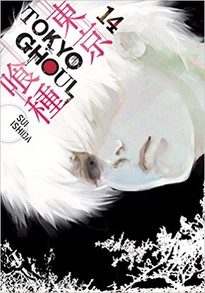Review
by Rebecca Silverman,Tokyo Ghoul
GN 14
| Synopsis: |  |
||
The fight between Kaneki and the CCG has come down to this: a final battle where neither side can see a way out. As Kaneki struggles to reconcile what he has become with who he once was and the CCG continues to persist in seeing ghouls as nothing more than the enemy, the struggle to decide who deserves to live and who must die comes to a head. Can there even be a conclusion when no one is agreed on the outcome? |
|||
| Review: | |||
While things are set to change in the sequel series, Tokyo Ghoul has maintained an interesting fidelity to Mary Shelley's Frankenstein throughout its fourteen volumes. While the themes of monster versus man have been obvious to many readers, it's also worth remembering at this point that Frankenstein himself was the creator of the monster. That his creation is often referred to by his name is also significant in the context of Tokyo Ghoul, as we are reminded in this final volume. In the ultimate question of who is more human, it is the “monster” who wins out in Shelley's novel—and it is the ghouls who are left more intact at the conclusion of Ishida's narrative. Of more importance, however, is the reminder we get toward the end of the book that Kaneki the ghoul was created, not born. That makes him very much Frankenstein's Monster, or as the Monster calls himself when speaking to Frankenstein, “the Adam of your labours.” It's no mistake that this gives connotations of godhood to those who made Kaneki what he is by the series' end. What they're trying to do may still be somewhat cloaked in mystery, but it's explicitly stated that Kaneki is the closest that they've come to success. This implies that they're trying to make some new strain of being, neither human nor ghoul, for their own nefarious purposes. It would also seem to indicate that Kaneki's attempts to reconcile his human half with his ghoul half is what they're ultimately looking for. This struggle that he faces becomes the focus of his final appearances within the book, as well as some of the most effective storytelling and imagery in the series' finale. It is revealed that Kaneki sees himself as two separate people leading two different lives: Before and After. This change is more marked by the change in hair color than the date of his ghoulish transformation, which makes sense seeing as that's when he gave up “humanity” all together. Kaneki looks on his changeover with more nostalgia than anything, seeing his human past as more innocent or symbolic of childhood. In some ways, this implies the change from human to ghoul was not so much rooted in a decision on how to live or what to eat, but came from the moment when he began to see the world as less than idyllic, reflecting on the death of his mother. Therefore, a ghoul is equally a human-eating creature and someone who cannot see the world as a positive place. With most of the more monstrous ghouls and CCG officers, we have seen this pessimism or striking need to hurt someone; the happier characters are more likely to try to make things work or look to the future with hope. That's exemplified in Touko's final lines and her transformation over the course of the story from angry to caring, growing into her humanity as Kaneki loses his own. Juzo's role in the finale also marks a major turning point for the character, although his is facilitated by a much more traumatic event. Although we know from earlier books that Juzo has reasons for being so out-of-control, the things he witnesses in this volume, as well as the damage done to his body by outside forces as opposed to his own self-modification, forces him to understand that there's no shame in becoming prey to softer emotions. Likewise, Akira is better able to admit that she cares after the events of this book, which should have major repercussions going forward into the sequel. The fact that neither character could avoid death despite remaining alive may be what positions them to be very different people in the future, and it's ultimately Arima and Kaneki who have facilitated these potential changes. Despite the strength of the story, there are definitely places where it becomes difficult to follow, especially since so many characters from disparate storylines are all coming together now. The art can also get somewhat confusing during the battles, mostly due to excessive use of thick black lines and dark tones. The story itself is strong enough to carry the book through these rough patches, however. At the close of the volume, just before the set up for re: Ghoul, the comment is made that another Kaneki can always be created. This feels like more than just a lead-in to the sequel series; it's a reminder that the true villains are still out there. Will their next Adam become, like Frankenstein's monster tells his creator, their fallen angel? If nothing else, we can hope that they learn, as the not-so-good doctor did in 1818, not to meddle with things beyond their ken. |
| Grade: | |||
|
Overall : A-
Story : A-
Art : B+
+ Good use of themes and ideas up through the end, setup for sequel feels relatively natural |
|||
| discuss this in the forum (3 posts) | | |||
| Production Info: | ||
|
Full encyclopedia details about Release information about |
||